radiator CHRYSLER ASPEN 2009 2.G Owners Manual
[x] Cancel search | Manufacturer: CHRYSLER, Model Year: 2009, Model line: ASPEN, Model: CHRYSLER ASPEN 2009 2.GPages: 481, PDF Size: 9.28 MB
Page 280 of 481
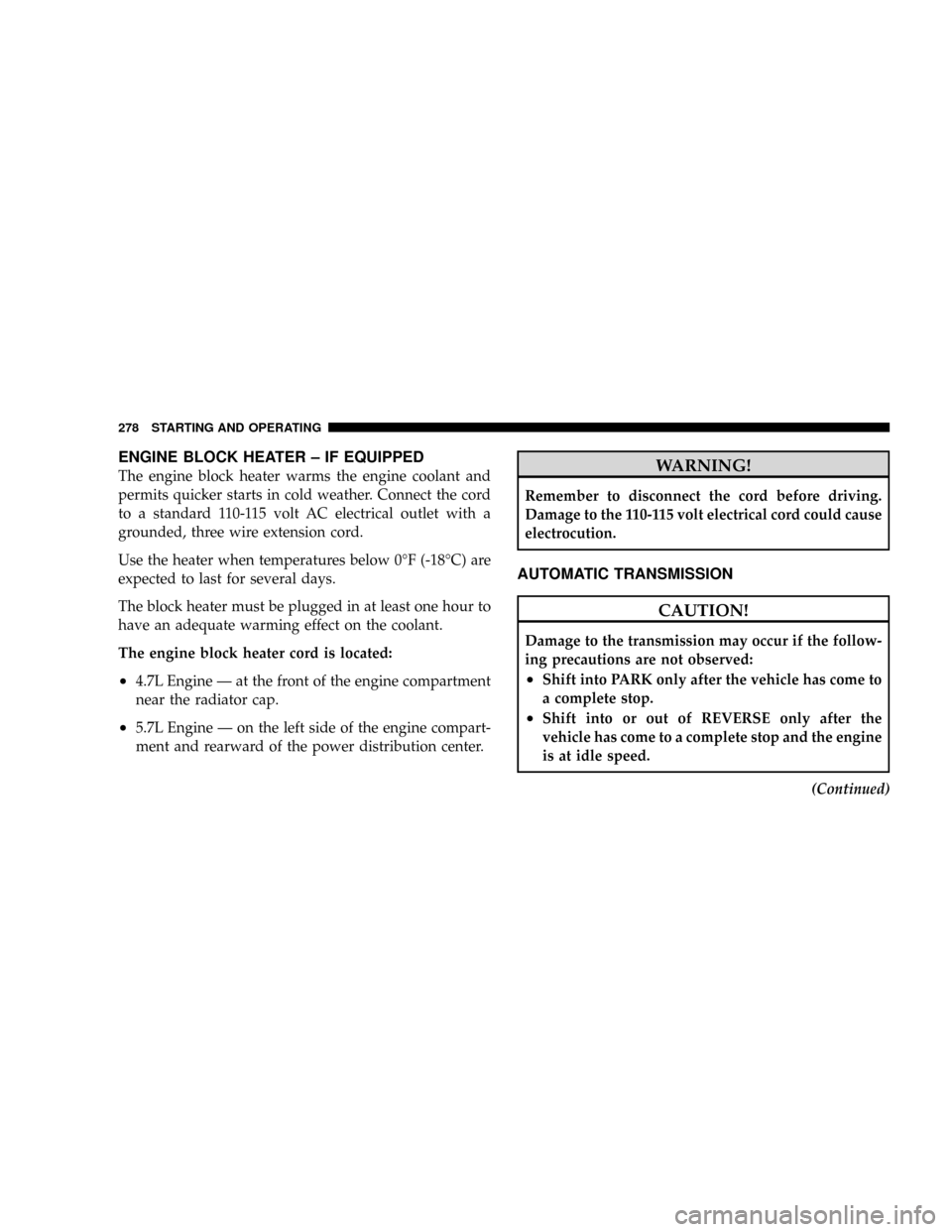
ENGINE BLOCK HEATER ± IF EQUIPPED
The engine block heater warms the engine coolant and
permits quicker starts in cold weather. Connect the cord
to a standard 110-115 volt AC electrical outlet with a
grounded, three wire extension cord.
Use the heater when temperatures below 0ÉF (-18ÉC) are
expected to last for several days.
The block heater must be plugged in at least one hour to
have an adequate warming effect on the coolant.
The engine block heater cord is located:
²4.7L Engine Ð at the front of the engine compartment
near the radiator cap.
²5.7L Engine Ð on the left side of the engine compart-
ment and rearward of the power distribution center.
WARNING!
Remember to disconnect the cord before driving.
Damage to the 110-115 volt electrical cord could cause
electrocution.
AUTOMATIC TRANSMISSION
CAUTION!
Damage to the transmission may occur if the follow-
ing precautions are not observed:
²Shift into PARK only after the vehicle has come to
a complete stop.
²Shift into or out of REVERSE only after the
vehicle has come to a complete stop and the engine
is at idle speed.
(Continued)
278 STARTING AND OPERATING
Page 399 of 481
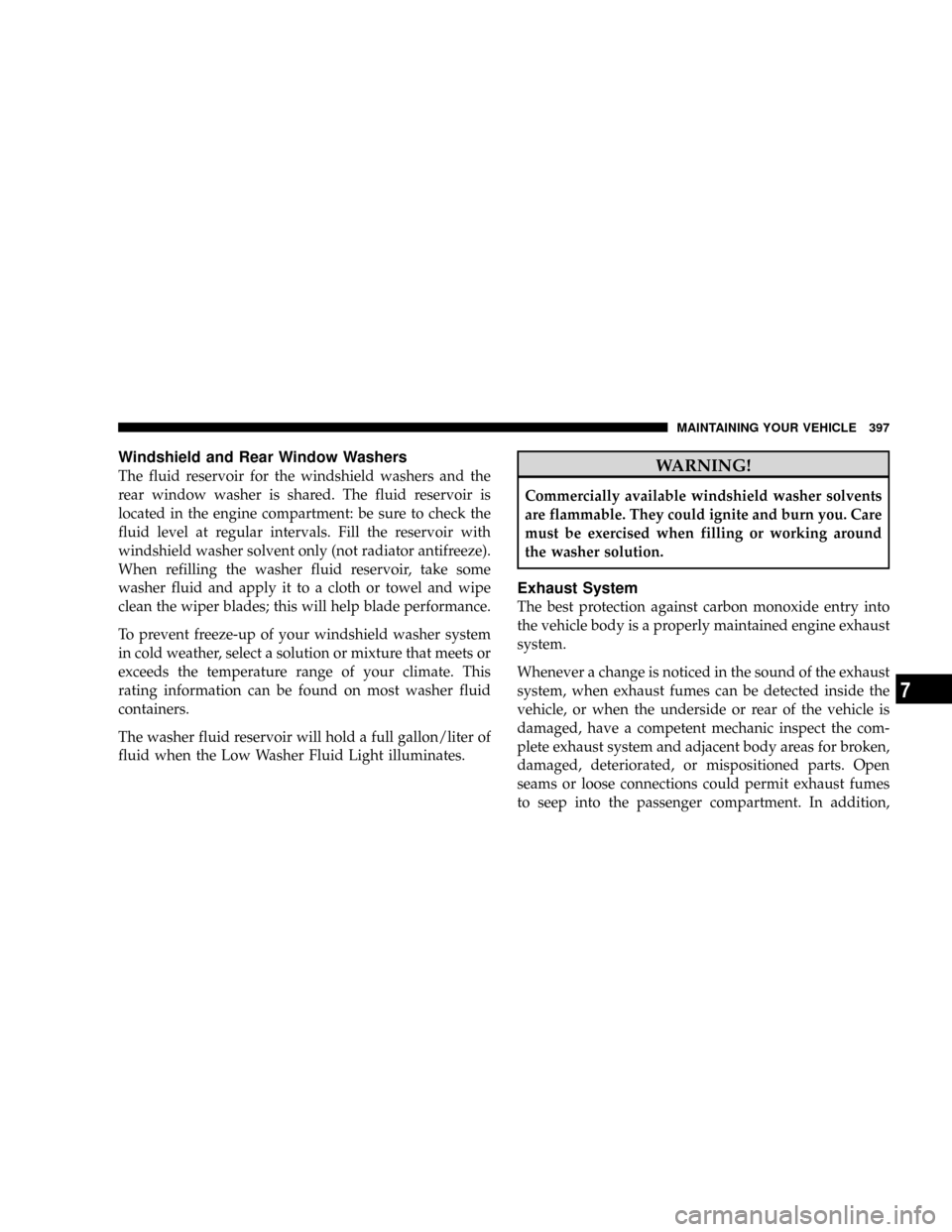
Windshield and Rear Window Washers
The fluid reservoir for the windshield washers and the
rear window washer is shared. The fluid reservoir is
located in the engine compartment: be sure to check the
fluid level at regular intervals. Fill the reservoir with
windshield washer solvent only (not radiator antifreeze).
When refilling the washer fluid reservoir, take some
washer fluid and apply it to a cloth or towel and wipe
clean the wiper blades; this will help blade performance.
To prevent freeze-up of your windshield washer system
in cold weather, select a solution or mixture that meets or
exceeds the temperature range of your climate. This
rating information can be found on most washer fluid
containers.
The washer fluid reservoir will hold a full gallon/liter of
fluid when the Low Washer Fluid Light illuminates.WARNING!
Commercially available windshield washer solvents
are flammable. They could ignite and burn you. Care
must be exercised when filling or working around
the washer solution.
Exhaust System
The best protection against carbon monoxide entry into
the vehicle body is a properly maintained engine exhaust
system.
Whenever a change is noticed in the sound of the exhaust
system, when exhaust fumes can be detected inside the
vehicle, or when the underside or rear of the vehicle is
damaged, have a competent mechanic inspect the com-
plete exhaust system and adjacent body areas for broken,
damaged, deteriorated, or mispositioned parts. Open
seams or loose connections could permit exhaust fumes
to seep into the passenger compartment. In addition,
MAINTAINING YOUR VEHICLE 397
7
Page 402 of 481
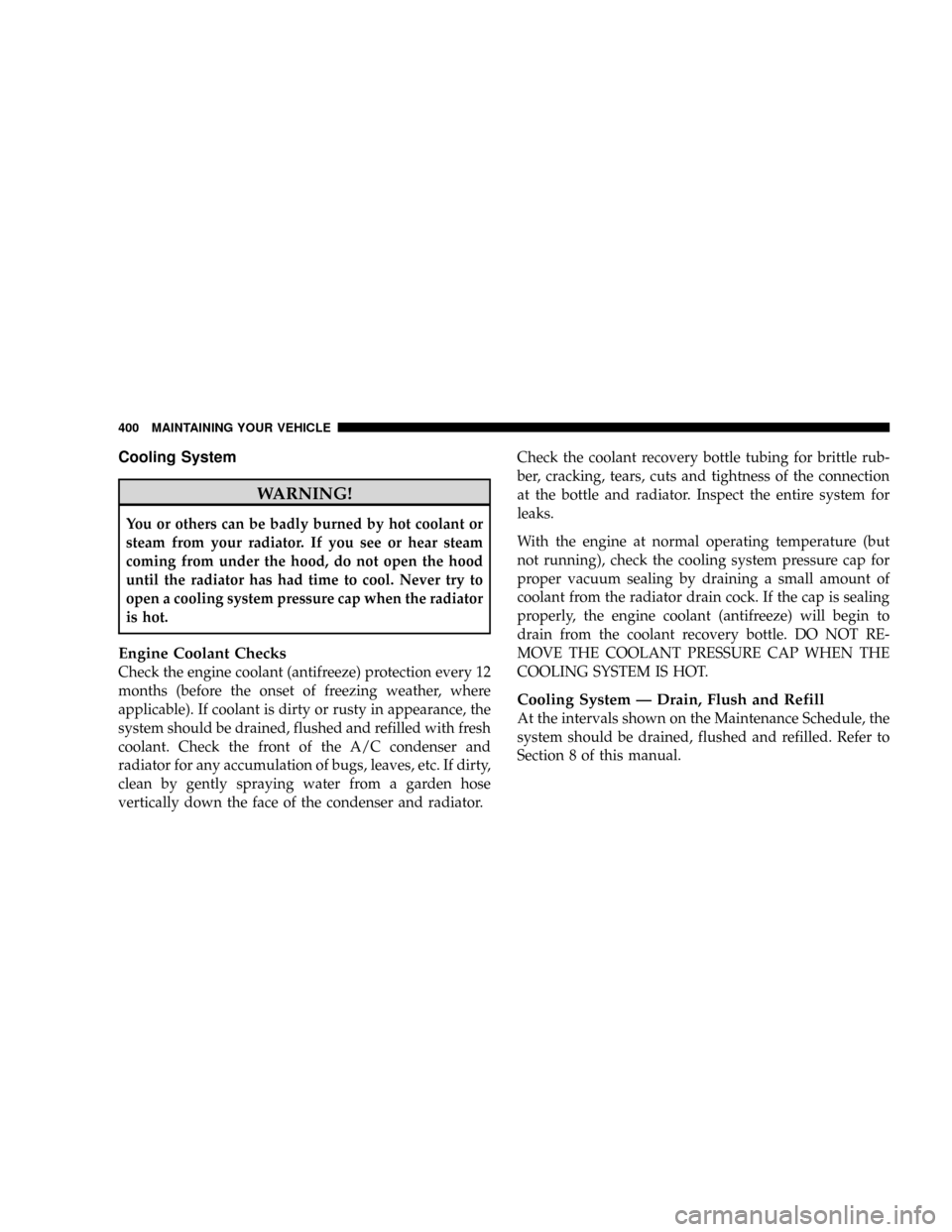
Cooling System
WARNING!
You or others can be badly burned by hot coolant or
steam from your radiator. If you see or hear steam
coming from under the hood, do not open the hood
until the radiator has had time to cool. Never try to
open a cooling system pressure cap when the radiator
is hot.
Engine Coolant Checks
Check the engine coolant (antifreeze) protection every 12
months (before the onset of freezing weather, where
applicable). If coolant is dirty or rusty in appearance, the
system should be drained, flushed and refilled with fresh
coolant. Check the front of the A/C condenser and
radiator for any accumulation of bugs, leaves, etc. If dirty,
clean by gently spraying water from a garden hose
vertically down the face of the condenser and radiator.Check the coolant recovery bottle tubing for brittle rub-
ber, cracking, tears, cuts and tightness of the connection
at the bottle and radiator. Inspect the entire system for
leaks.
With the engine at normal operating temperature (but
not running), check the cooling system pressure cap for
proper vacuum sealing by draining a small amount of
coolant from the radiator drain cock. If the cap is sealing
properly, the engine coolant (antifreeze) will begin to
drain from the coolant recovery bottle. DO NOT RE-
MOVE THE COOLANT PRESSURE CAP WHEN THE
COOLING SYSTEM IS HOT.
Cooling System Ð Drain, Flush and Refill
At the intervals shown on the Maintenance Schedule, the
system should be drained, flushed and refilled. Refer to
Section 8 of this manual.
400 MAINTAINING YOUR VEHICLE
Page 403 of 481
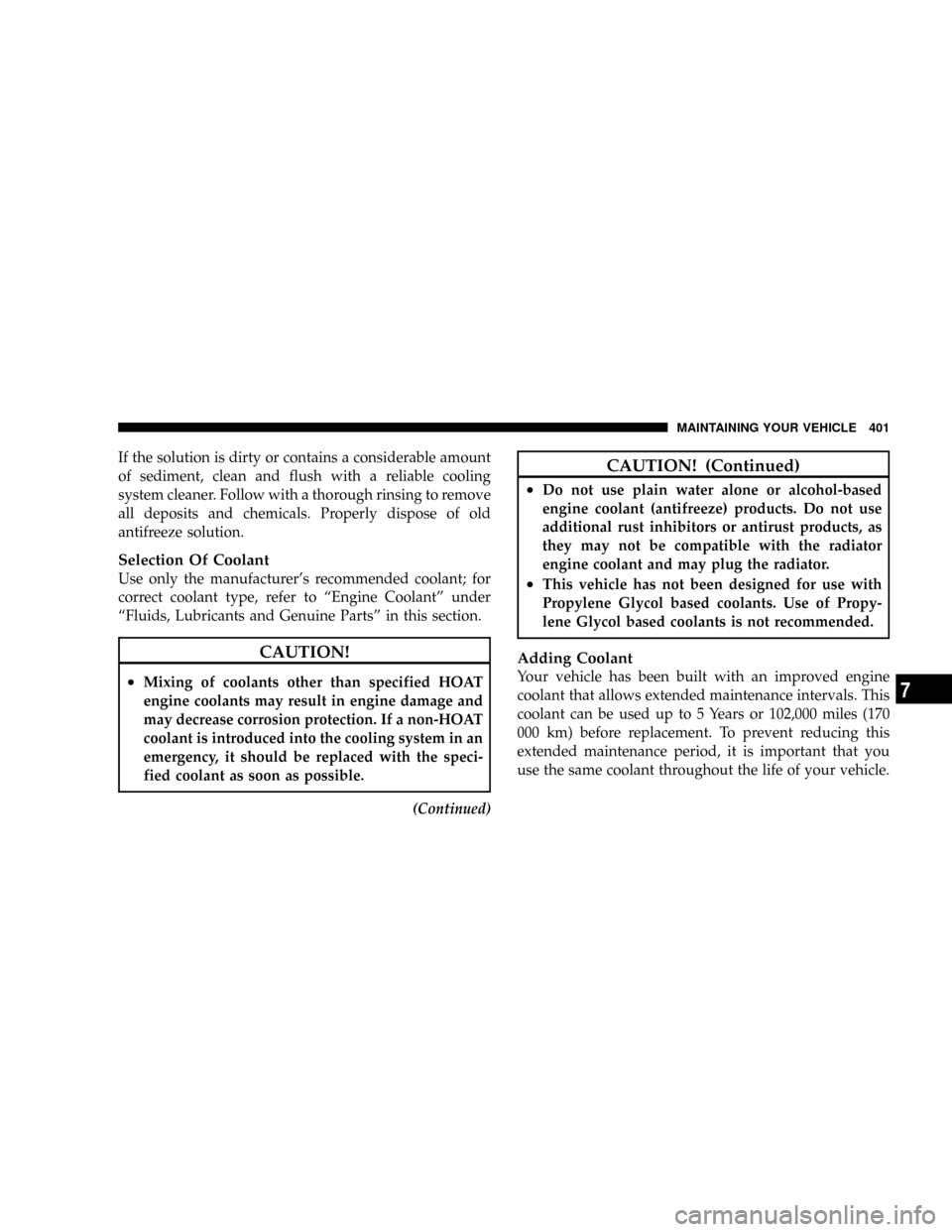
If the solution is dirty or contains a considerable amount
of sediment, clean and flush with a reliable cooling
system cleaner. Follow with a thorough rinsing to remove
all deposits and chemicals. Properly dispose of old
antifreeze solution.
Selection Of Coolant
Use only the manufacturer's recommended coolant; for
correct coolant type, refer to ªEngine Coolantº under
ªFluids, Lubricants and Genuine Partsº in this section.
CAUTION!
²Mixing of coolants other than specified HOAT
engine coolants may result in engine damage and
may decrease corrosion protection. If a non-HOAT
coolant is introduced into the cooling system in an
emergency, it should be replaced with the speci-
fied coolant as soon as possible.
(Continued)
CAUTION! (Continued)
²Do not use plain water alone or alcohol-based
engine coolant (antifreeze) products. Do not use
additional rust inhibitors or antirust products, as
they may not be compatible with the radiator
engine coolant and may plug the radiator.
²This vehicle has not been designed for use with
Propylene Glycol based coolants. Use of Propy-
lene Glycol based coolants is not recommended.
Adding Coolant
Your vehicle has been built with an improved engine
coolant that allows extended maintenance intervals. This
coolant can be used up to 5 Years or 102,000 miles (170
000 km) before replacement. To prevent reducing this
extended maintenance period, it is important that you
use the same coolant throughout the life of your vehicle.
MAINTAINING YOUR VEHICLE 401
7
Page 404 of 481
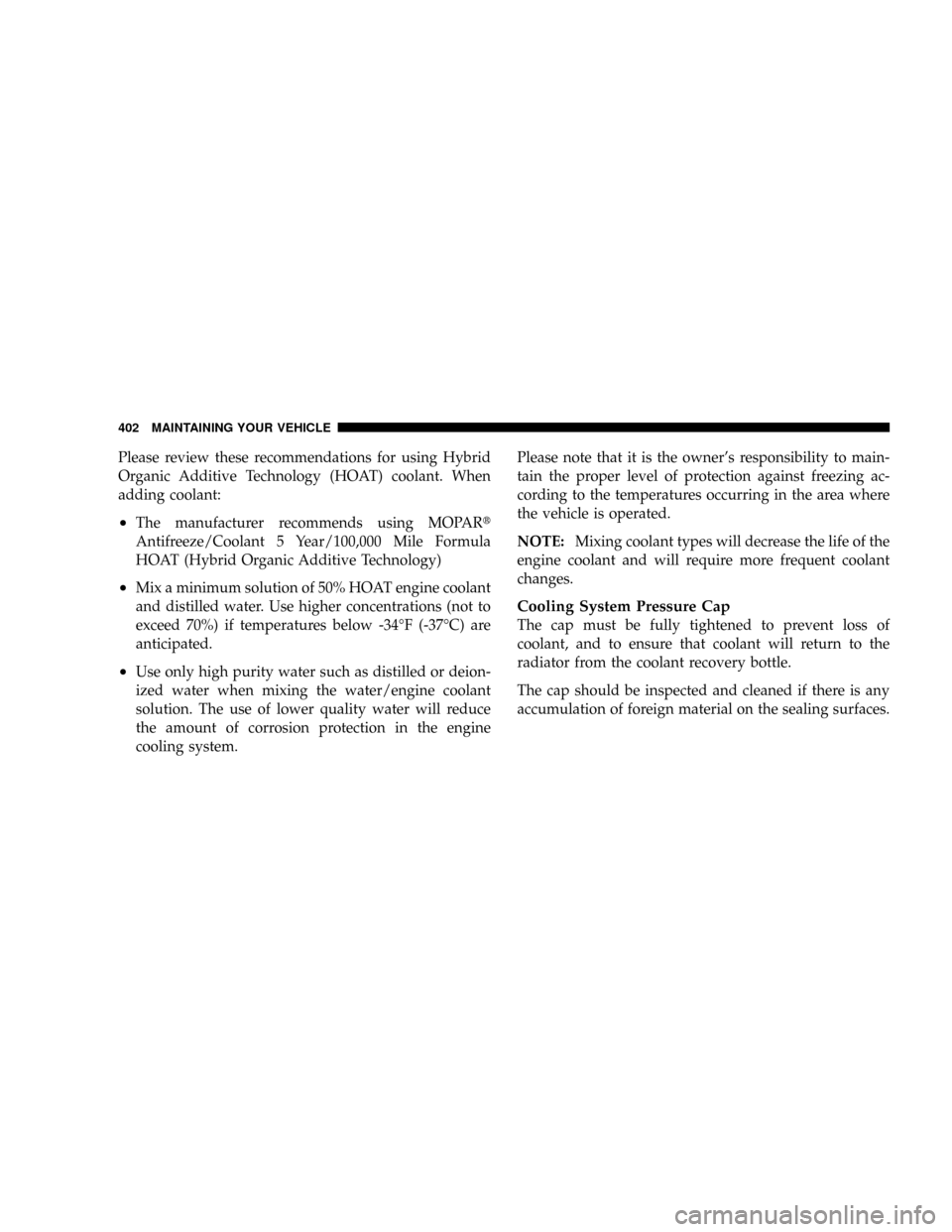
Please review these recommendations for using Hybrid
Organic Additive Technology (HOAT) coolant. When
adding coolant:
²The manufacturer recommends using MOPARt
Antifreeze/Coolant 5 Year/100,000 Mile Formula
HOAT (Hybrid Organic Additive Technology)
²Mix a minimum solution of 50% HOAT engine coolant
and distilled water. Use higher concentrations (not to
exceed 70%) if temperatures below -34ÉF (-37ÉC) are
anticipated.
²Use only high purity water such as distilled or deion-
ized water when mixing the water/engine coolant
solution. The use of lower quality water will reduce
the amount of corrosion protection in the engine
cooling system.Please note that it is the owner's responsibility to main-
tain the proper level of protection against freezing ac-
cording to the temperatures occurring in the area where
the vehicle is operated.
NOTE:Mixing coolant types will decrease the life of the
engine coolant and will require more frequent coolant
changes.
Cooling System Pressure Cap
The cap must be fully tightened to prevent loss of
coolant, and to ensure that coolant will return to the
radiator from the coolant recovery bottle.
The cap should be inspected and cleaned if there is any
accumulation of foreign material on the sealing surfaces.
402 MAINTAINING YOUR VEHICLE
Page 405 of 481

WARNING!
²The warning words ªDO NOT OPEN HOTº on
the cooling system pressure cap are a safety pre-
caution. Never add coolant when the engine is
overheated. Do not loosen or remove the cap to
cool an overheated engine. Heat causes pressure to
build up in the cooling system. To prevent scald-
ing or injury, do not remove the pressure cap while
the system is hot or under pressure.
²Do not use a pressure cap other than the one
specified for your vehicle. Personal injury or en-
gine damage may result.
Disposal of Used Engine Coolant
Used ethylene glycol-based engine coolant is a regulated
substance requiring proper disposal. Check with your
local authorities to determine the disposal rules for your
community. To prevent ingestion by animals or childrendo not store ethylene glycol-based engine coolant in open
containers or allow it to remain in puddles on the
ground. If ingested by a child, contact a physician
immediately. Clean up any ground spills immediately.
Coolant Level
The coolant bottle provides a quick visual method for
determining that the coolant level is adequate. With the
engine cold, the level of the coolant in the coolant
recovery bottle should be between the ranges indicated
on the bottle dipstick.
The radiator normally remains completely full, so there is
no need to remove the radiator cap unless checking for
coolant freeze point or replacing coolant. Advise your
service attendant of this. As long as the engine operating
temperature is satisfactory, the coolant bottle need only
be checked once a month.
MAINTAINING YOUR VEHICLE 403
7
Page 406 of 481
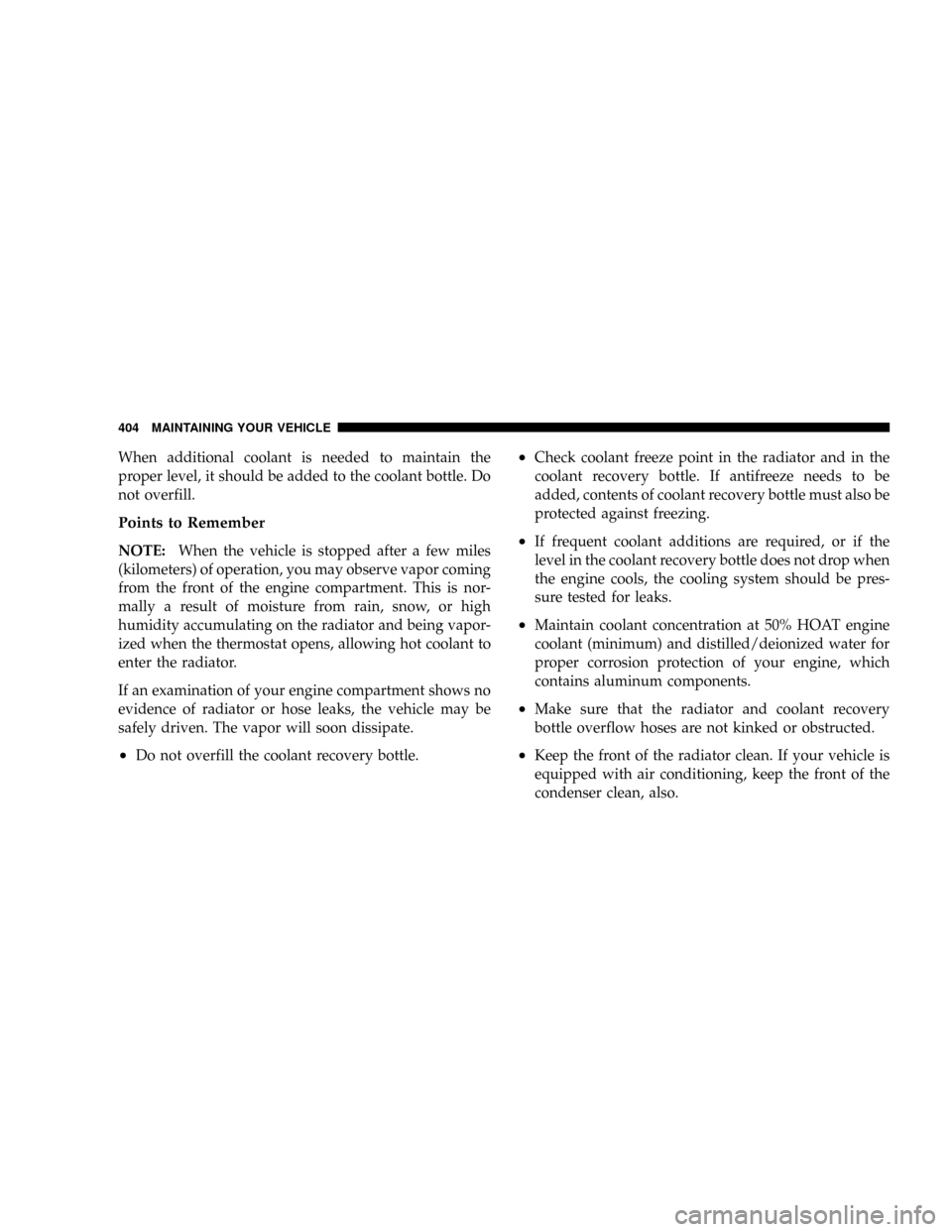
When additional coolant is needed to maintain the
proper level, it should be added to the coolant bottle. Do
not overfill.
Points to Remember
NOTE:When the vehicle is stopped after a few miles
(kilometers) of operation, you may observe vapor coming
from the front of the engine compartment. This is nor-
mally a result of moisture from rain, snow, or high
humidity accumulating on the radiator and being vapor-
ized when the thermostat opens, allowing hot coolant to
enter the radiator.
If an examination of your engine compartment shows no
evidence of radiator or hose leaks, the vehicle may be
safely driven. The vapor will soon dissipate.
²Do not overfill the coolant recovery bottle.
²Check coolant freeze point in the radiator and in the
coolant recovery bottle. If antifreeze needs to be
added, contents of coolant recovery bottle must also be
protected against freezing.
²If frequent coolant additions are required, or if the
level in the coolant recovery bottle does not drop when
the engine cools, the cooling system should be pres-
sure tested for leaks.
²Maintain coolant concentration at 50% HOAT engine
coolant (minimum) and distilled/deionized water for
proper corrosion protection of your engine, which
contains aluminum components.
²Make sure that the radiator and coolant recovery
bottle overflow hoses are not kinked or obstructed.
²Keep the front of the radiator clean. If your vehicle is
equipped with air conditioning, keep the front of the
condenser clean, also.
404 MAINTAINING YOUR VEHICLE
Page 423 of 481

An integrated power module is located in the left side of
the engine compartment. This center contains cartridge
fuses, mini fuses and relays. A description of each fuse
and component may be stamped on the inside cover,
otherwise the cavity number of each fuse is stamped on
the inside cover that corresponds to the following chart.
Cav-
ityCartridge
Fuse /
RelayMini Fuse Description
1 Relay Wiper On/Off Rly
2 Relay Wiper Hi/Lo Rly
3 Relay Horn Rly
4 Relay Rear Wiper Rly
5 Relay Lt Trailer-Tow Stop/
Turn Rly
6 Relay Rt Trailer-Tow Stop/
Turn Rly
7 Relay Park Lamps Rly
Cav-
ityCartridge
Fuse /
RelayMini Fuse Description
8 10 Amp
RedLt Park Lamps
9 10 Amp
RedTrailer-Tow Park
Lamps
10 10 Amp
RedRt Park Lamps
11 Relay Radiator Fan Hi Rly
12 20 Amp
YellowFront Control Module
(FCM) Batt #4
13 20 Amp
YellowFront Control Module
(FCM) Batt #2
14 20 Amp
YellowAdjustable Pedal
15 20 Amp
YellowFt Fog Lamps
MAINTAINING YOUR VEHICLE 421
7
Page 424 of 481
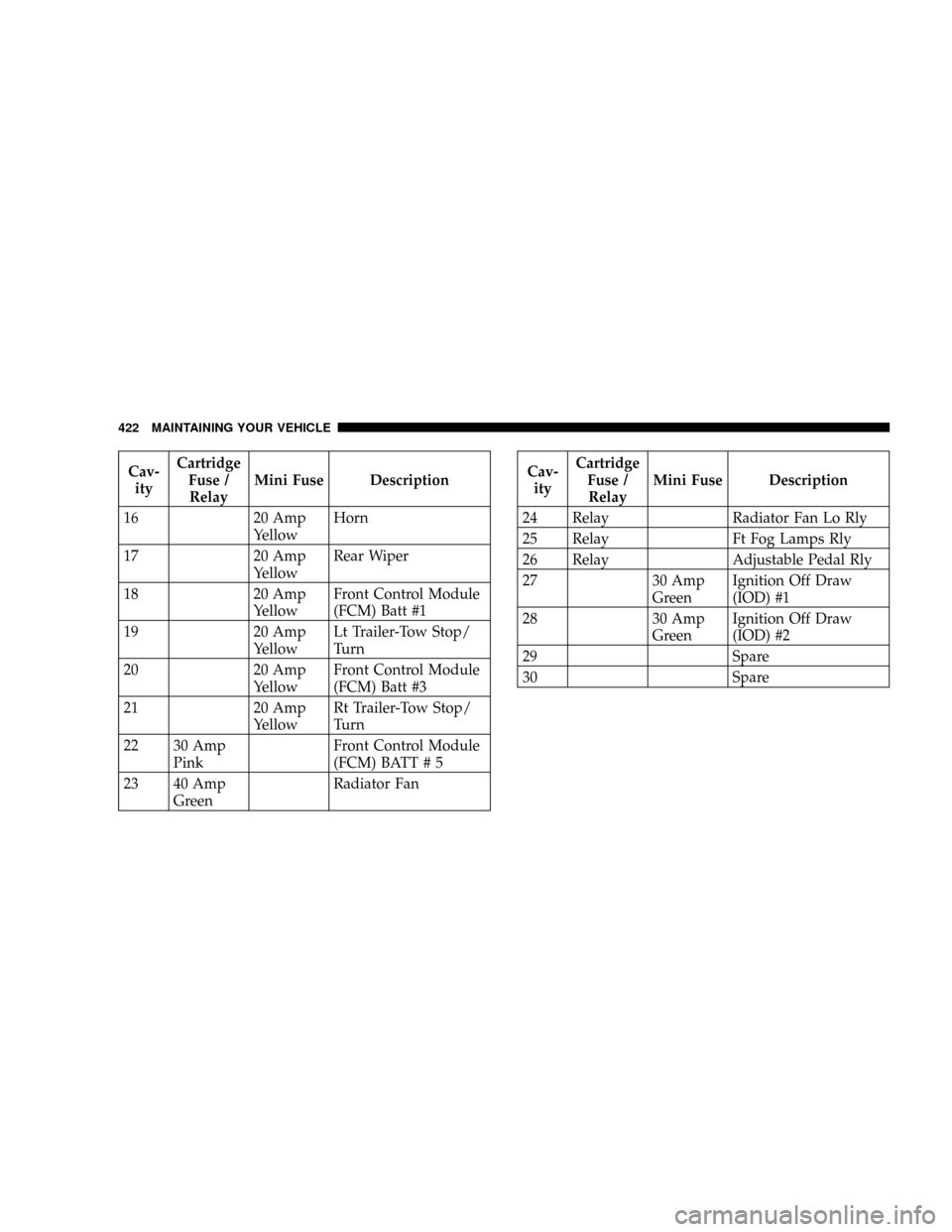
Cav-
ityCartridge
Fuse /
RelayMini Fuse Description
16 20 Amp
YellowHorn
17 20 Amp
YellowRear Wiper
18 20 Amp
YellowFront Control Module
(FCM) Batt #1
19 20 Amp
YellowLt Trailer-Tow Stop/
Turn
20 20 Amp
YellowFront Control Module
(FCM) Batt #3
21 20 Amp
YellowRt Trailer-Tow Stop/
Turn
22 30 Amp
PinkFront Control Module
(FCM) BATT # 5
23 40 Amp
GreenRadiator FanCav-
ityCartridge
Fuse /
RelayMini Fuse Description
24 Relay Radiator Fan Lo Rly
25 Relay Ft Fog Lamps Rly
26 Relay Adjustable Pedal Rly
27 30 Amp
GreenIgnition Off Draw
(IOD) #1
28 30 Amp
GreenIgnition Off Draw
(IOD) #2
29 Spare
30 Spare
422 MAINTAINING YOUR VEHICLE
Page 463 of 481
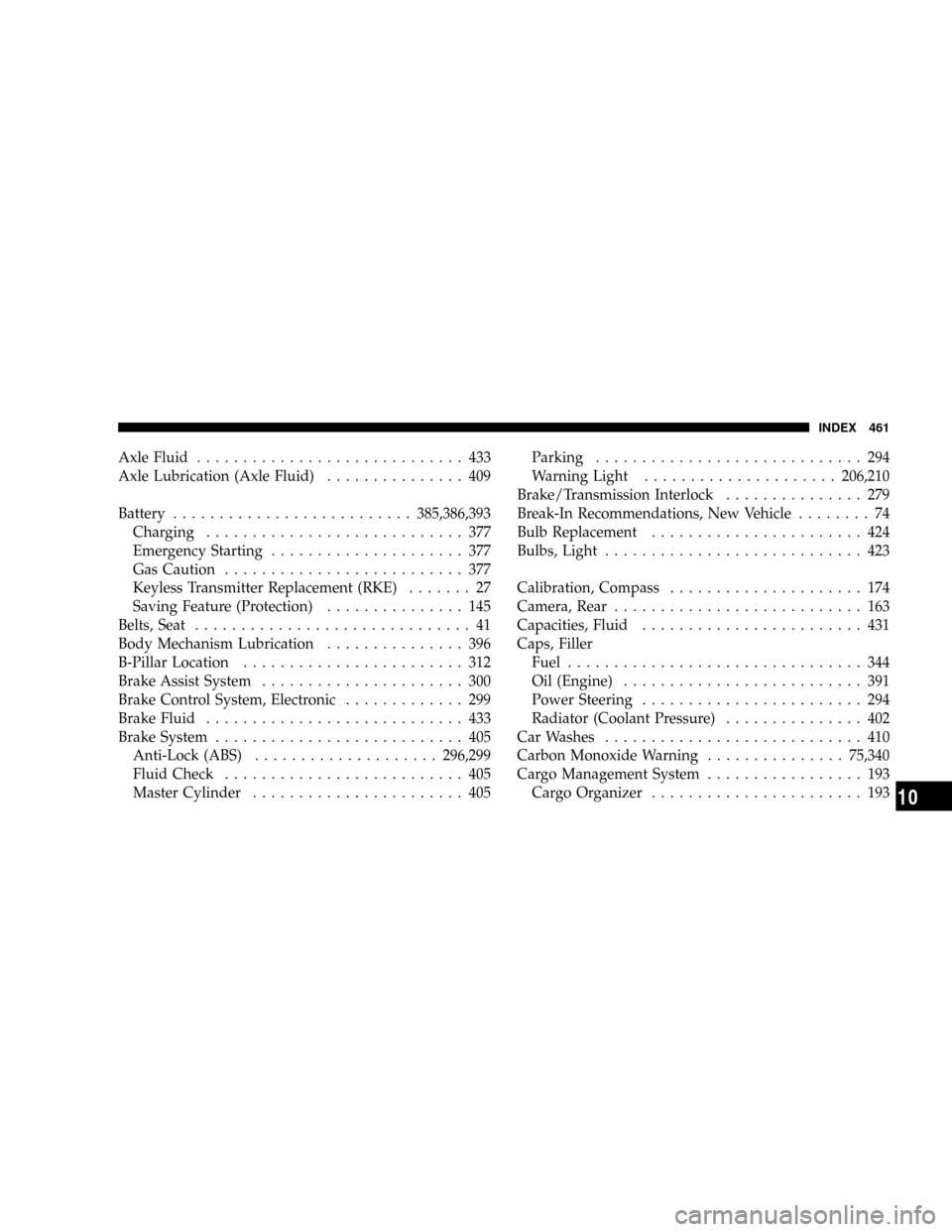
Axle Fluid............................. 433
Axle Lubrication (Axle Fluid)............... 409
Battery..........................385,386,393
Charging............................ 377
Emergency Starting..................... 377
Gas Caution.......................... 377
Keyless Transmitter Replacement (RKE)....... 27
Saving Feature (Protection)............... 145
Belts, Seat.............................. 41
Body Mechanism Lubrication............... 396
B-Pillar Location........................ 312
Brake Assist System...................... 300
Brake Control System, Electronic............. 299
Brake Fluid............................ 433
Brake System........................... 405
Anti-Lock (ABS)....................296,299
Fluid Check.......................... 405
Master Cylinder....................... 405Parking............................. 294
Warning Light.....................206,210
Brake/Transmission Interlock............... 279
Break-In Recommendations, New Vehicle........ 74
Bulb Replacement....................... 424
Bulbs, Light............................ 423
Calibration, Compass..................... 174
Camera, Rear........................... 163
Capacities, Fluid........................ 431
Caps, Filler
Fuel................................ 344
Oil (Engine).......................... 391
Power Steering........................ 294
Radiator (Coolant Pressure)............... 402
Car Washes............................ 410
Carbon Monoxide Warning...............75,340
Cargo Management System................. 193
Cargo Organizer....................... 193
INDEX 461
10